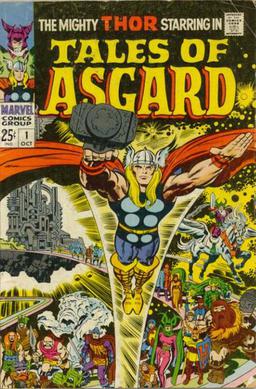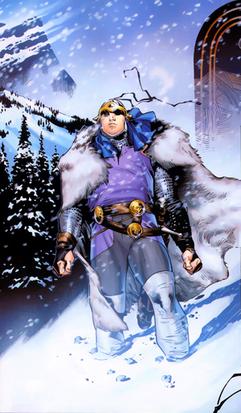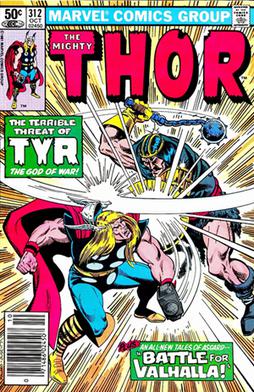Related Research Articles
In Nordic mythology, Asgard is a location associated with the gods. It appears in several Old Norse sagas and mythological texts, including the Eddas, however it has also been suggested to be referred to indirectly in some of these sources. It is described as the fortified home of the Æsir gods and is often associated with gold imagery and contains many other locations known in Nordic mythology such as Valhöll, Iðavöllr and Hlidskjálf.

In Norse mythology, Ragnarök is a foretold series of impending events, including a great battle in which numerous great Norse mythological figures will perish ; it will entail a catastrophic series of natural disasters, including the burning of the world, and culminate in the submersion of the world underwater. After these events, the world will rise again, cleansed and fertile, the surviving and returning gods will meet, and the world will be repopulated by two human survivors, Líf and Lífþrasir. Ragnarök is an important event in Norse mythology and has been the subject of scholarly discourse and theory in the history of Germanic studies.

In Norse mythology, Surtr, also sometimes written Surt in English, is a jötunn; he is the greatest of the fire giants, who serves as the guardian of Muspelheim which is along with Niflheim, the only two realms to exist before the beginning of time. Surtr is attested in the Poetic Edda, compiled in the 13th century from earlier traditional sources, and the Prose Edda, written in the 13th century by Snorri Sturluson. In both sources, Surtr is foretold as being a major figure during the events of Ragnarök; carrying his bright sword, he will go to battle against the Æsir, he will battle the major god Freyr, and afterward the flames that he brings forth will engulf the Earth.

Asgard is a fictional realm and its capital city appearing in American comic books published by Marvel Comics. Created by Stan Lee, Larry Lieber and Jack Kirby, the realm first appeared in Journey into Mystery #85. Based on the realm of the same name from Germanic mythology, Asgard is home to the Asgardians and other beings adapted from Norse mythology. It features prominently in stories that follow the Marvel Comics superhero Thor.

Balder the Brave is a fictional character appearing in American comic books published by Marvel Comics. The character is based on the deity Baldr from Norse mythology.

Odin Borson, the All-Father is a fictional character appearing in American comic books published by Marvel Comics. First mentioned in Journey into Mystery #85, the character first appears in Journey into Mystery #86, and was adapted from the Odin of Norse mythology by Stan Lee and Jack Kirby. The character is depicted as the father of Thor and, traditionally, as the king of Asgard.

Riviera: The Promised Land is a role-playing video game originally produced in 2002 by Sting Entertainment for WonderSwan Color as the first episode of the Dept. Heaven series of games. The game was later introduced to Nintendo's Game Boy Advance in 2004, which Atlus USA released in North America in 2005. An enhanced remake was released for the PlayStation Portable in November 2006, and was released in July 2007 in North America by Atlus USA. In July 2023, an HD remaster was announced for Microsoft Windows, Nintendo Switch, iOS and Android. The HD remaster released on Steam in July 2024.

Heimdall is a fictional character appearing in American comic books published by Marvel Comics. The character is based on the Norse deity Heimdall. Heimdall is described as all-seeing and all-hearing and is the sole protector of the Bifröst in Asgard.
The Norse mythology, preserved ancient Icelandic texts such as the Poetic Edda, the Prose Edda, and other lays and sagas, was little known outside Scandinavia until the 19th century. With the widespread publication of Norse myths and legends at this time, references to the Norse gods and heroes spread into European literary culture, especially in Scandinavia, Germany, and Britain. In the later 20th century, references to Norse mythology became common in science fiction and fantasy literature, role-playing games, and eventually other cultural products such as Japanese animation. Storytelling was an important aspect of Norse mythology and centuries later, with the rediscovery of the myth, Norse mythology once again relies on the impacts of storytelling to spread its agenda.

Surtur is a fictional character appearing in American comic books published by Marvel Comics, commonly as an enemy of Thor. Based on the fire giant Surtr from Norse mythology, he was adapted by writer Stan Lee and artist Jack Kirby, and first appeared in Journey into Mystery #97. The character was once described as one of "The Ten Most Heinous Enemies of the Mighty Thor".

Tyr is a fictional character, an Asgardian god appearing in American comic books published by Marvel Comics. The character is based on the Norse god of the same name. Along with Thor and Balder, he is one of Odin's biological sons.

Yggdra Union: We'll Never Fight Alone is a tactical role-playing game for the Game Boy Advance and PlayStation Portable, developed by Sting Entertainment as the second episode of the Dept. Heaven saga of games. Atlus USA localized and published both versions of the game in North America. 505 Games published the Game Boy Advance version in a limited number of European countries, such as Italy and France. A Nintendo DS side-game was released in Japan on December 3, 2009, as Yggdra Unison: Seiken Buyuuden. An updated version with bonus features was released in Japan for mobile platforms and Nintendo Switch in April 2019 and March 2020, respectively. A Windows version was released in early access on February 6, 2023, with a full release following on July 27, 2023, alongside a western release for Nintendo Switch.

Viking: Battle for Asgard is an action-adventure video game developed by Creative Assembly and published by Sega. It was released in North America on 25 March and Europe on 28 March 2008. The game is based on Norse mythology, where the war between the gods has sparked further conflict in the mortal realm of Midgard, where Freya's champion Skarin must lead Viking forces against that of the Goddess Hel.

Knights in the Nightmare is a strategy-shooter role-playing game hybrid from Sting Entertainment, and the fourth episode in the Dept. Heaven series of video games. It was released by Atlus USA in North America. Sting released a special edition version of Knights in the Nightmare, called the Knights in the Nightmare DHE Series Special Pack; it includes a copy of Yggdra Union: We'll Never Fight Alone for the Game Boy Advance.

The characters of the God of War video game franchise belong to a fictional universe based on Greek mythology and Norse mythology. As such, the series features a range of traditional figures, including those from Greek mythology, such as the Olympian Gods, Titans, and Greek heroes, and those from Norse mythology, including the Æsir and Vanir gods and other beings. A number of original characters have also been created to supplement storylines.

Blaze Union: Story to Reach the Future is a tactical role-playing game for the PlayStation Portable, developed by Sting Entertainment and published by Atlus, with its scenario written by R-Force Entertainment. It is currently only available in Japanese.

Gungnir,, is a tactical role-playing game for the PlayStation Portable, developed by Sting Entertainment and published by Atlus. It is Episode IX of the Dept. Heaven series, and was released in Japan on May 19, 2011 after two years of development.

Animax was a Latin American cable television channel, serving as the regional variant of the Japanese network of the same name. It was launched on 31 July 2005, replacing Locomotion, which was acquired by Sony on 18 January of the same year. Animax was divided into four feeds: three in Spanish and one in Portuguese (Brazil).
References
- ↑ "Yggdra Union 3-in-1 Physical Package Coming to Japan". 5 September 2023.
- 1 2 3 4 "Sting Teases Riviera: The Promised Land Remaster". 12 July 2023.
- ↑ "Riviera: The Promised Land Remaster announced". 12 July 2023.
- ↑ Dengeki Online Interview with Shinichi Ito. Retrieved October 31, 2008
- ↑ http://www.famitsu.com/game/coming/1213583_1407.html Retrieved February 17, 2008
- ↑ "られしは", Dengeki Maoh , pp. 502–503, April 2008 Retrieved August 19, 2008
- 1 2 Dept. Heaven World Guidance. Softbank Creative. 2008. p. 120 ( ISBN 978-4797348798)
- 1 2 3 4 Dept. Heaven World Guidance. Softbank Creative. 2008. pp. 118-119 ( ISBN 978-4797348798)
- 1 2 3 4 Dept. Heaven World Guidance. Softbank Creative. 2008. pp. 114-115 ( ISBN 978-4797348798)
- 1 2 3 Dept. Heaven World Guidance. Softbank Creative. 2008. pp. 110-111 ( ISBN 978-4797348798)
- 1 2 Dept. Heaven World Guidance. Softbank Creative. 2008. pp. 130-133 ( ISBN 978-4797348798)
- 1 2 3 4 Dept. Heaven World Guidance. Softbank Creative. 2008. pp. 112-113 ( ISBN 978-4797348798)
- ↑ Dept. Heaven World Guidance. Softbank Creative. 2008. pp. 108-109 ( ISBN 978-4797348798)
- ↑ Dept. Heaven World Guidance. Softbank Creative. 2008. p. 122-129 ( ISBN 978-4797348798)